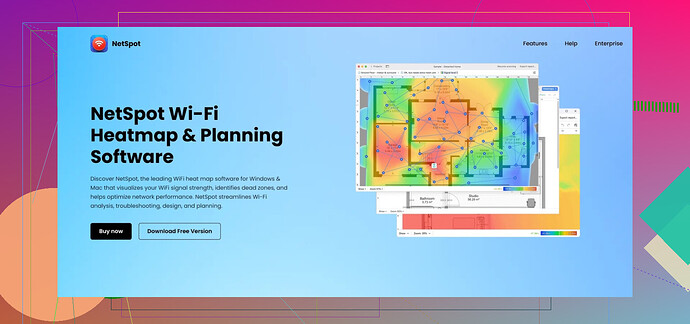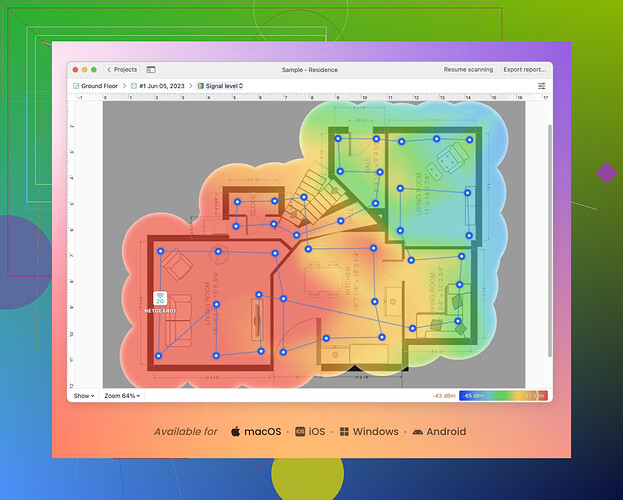I’m planning to upgrade my home and office network setup in 2025. I want the best tool for creating WiFi heat maps to optimize signal strength and coverage. What are the top recommended software options expected in 2025? Any advice would be helpful.
Top WiFi Heatmap Software for Homes, Small Businesses, and Enterprises
WiFi heatmap tools are essential for analyzing wireless signal coverage, spotting dead zones, and perfecting router placement for optimal performance. Below, you’ll find a curated list of the best WiFi heatmap software available—both free and paid—with key features, drawbacks, and overall verdicts to guide your decision.
1. NetSpot – Versatility at Its Best
Why It Works:
-
Pros:
- Beginner-friendly design with an intuitive interface.
- Practical for home setups, small businesses, and even enterprises.
- Compatible with both Windows and macOS.
-
Cons:
- The free version limits the number of survey points available.
- Some advanced features are locked behind a paywall.
The Verdict:
A stellar all-purpose choice perfect for everyone from casual users to seasoned professionals. Easy to learn yet powerful enough for in-depth wireless analysis.
2. Ekahau AI Pro – Excellence for Enterprises
![]() Ekahau AI Pro Official Website
Ekahau AI Pro Official Website
The Highlights:
-
Pros:
- Leverages AI for sophisticated planning and troubleshooting.
- Creates advanced heatmaps and detects interference.
- Tailored for massive, high-demand networks.
-
Cons:
- Comes with a hefty price tag.
- Best suited for IT experts, requiring specialized training.
The Verdict:
A powerhouse designed for enterprise-grade wireless infrastructure. However, its complexity and cost make it less ideal for home or small business use.
3. Acrylic Wi-Fi Heatmaps – Pay Less, Get More for Small Businesses
![]() Acrylic Wi-Fi Heatmaps Official Website
Acrylic Wi-Fi Heatmaps Official Website
Why It’s Valuable:
-
Pros:
- Budget-friendly when compared to enterprise-level options.
- Provides a clear visualization of WiFi signal strength.
- Ideal for planning access point (AP) placements.
-
Cons:
- Exclusively available for Windows users.
- The free trial doesn’t offer full functionality.
The Verdict:
For small businesses seeking an affordable yet professional-level solution, Acrylic Wi-Fi Heatmaps strikes a solid balance.
4. SolarWinds Network Performance Monitor – A Titan for Large Organizations
The Advantages:
-
Pros:
- Generates live, real-time WiFi heatmaps.
- Monitors complex networks with high precision.
-
Cons:
- Requires a Windows server to run.
- Not user-friendly for smaller-scale setups.
The Verdict:
A fantastic fit for IT departments overseeing large wireless ecosystems. Overly complex, though, for home or small-scale environments.
5. VisiWave Site Survey – Perfect for Indoor and Outdoor Networks
What Stands Out:
-
Pros:
- Stunning 3D visualizations for WiFi coverage analysis.
- GPS integration enables outdoor mapping capabilities.
-
Cons:
- Only compatible with Windows systems.
- Does not support ongoing monitoring.
The Verdict:
For those needing comprehensive indoor or outdoor network visualizations, this tool checks all the right boxes.
6. TamoGraph Site Survey – Built for the Pros
Main Perks:
-
Pros:
- Supports all modern WiFi standards, including 802.11ax, 5GHz, and 6GHz bands.
- Works across Windows and macOS devices.
-
Cons:
- Pricing excludes free usage—it’s a paid tool only.
- Lacks a mobile application.
The Verdict:
Offers professional-grade functionality at a somewhat reduced cost when compared to enterprise-focused options.
7. MetaGeek inSSIDer – Simple WiFi Diagnostics
Key Features:
-
Pros:
- Provides quick, efficient WiFi scanning.
- Pinpoints interference and suggests optimal channels.
-
Cons:
- Doesn’t include heatmap generation features.
- Only available for Windows platforms.
The Verdict:
While it’s effective for fast diagnostics, this lightweight tool lacks true heatmapping capabilities, limiting its utility for deeper analysis.
Wrapping It Up
Choosing the right WiFi heatmap tool largely depends on your specific needs and budget. Here’s a recap:
- Best Overall Tool: NetSpot

- Top Choice for Enterprises: Ekahau AI Pro

- Best for Small Businesses: Acrylic Wi-Fi Heatmaps

With these options, you’re equipped to enhance your WiFi network efficiency—whether you’re solving lagging connectivity at home, boosting business productivity, or optimizing vast enterprise setups.
Honestly, picking ‘the best’ WiFi heatmap tool for 2025 might feel like choosing between Oscar nominees – they all bring their own set of strengths and quirks to the table. While @mikeappsreviewer laid out a solid lineup, I’m going to throw in my two cents, and maybe question a couple of their picks, just to keep it spicy.
If you’re talking versatility and ease of use, NetSpot really does shine, especially for non-techies. The interface is clean, and it doesn’t make you feel like you need a PhD in IT to move your router two inches for better coverage at home. Plus, the level of detail when diagnosing dead zones is honestly impressive. If you want to dive into it, they’ve got a great breakdown on WiFi mapping and optimization. That said, the free version can feel a bit limiting – almost like the appetizer that just makes you hungrier for more.
Now, Ekahau AI Pro is a BEAST, yeah, but does everyone really need a Lamborghini just to run errands? Its AI-driven functionality is futuristic and all, but ut’s likely overkill for a tiny office or home setup. Plus, the price tag might have you clutching your wallet in fear. Unless you’re Elon Musk planning a networking overhaul for Mars, it’s better suited for enterprise IT teams.
On the flip side, Acrylic Wi-Fi Heatmaps could be a hidden gem for SMBs or budget-conscious folks. While it’s a bit basic compared to the fancy tools, it gets the job done for smaller spaces—although I can’t understand why they still limit themselves to Windows users. Uh, hello? MacBooks exist.
Now, do we wanna talk about SolarWinds Network Performance Monitor? Or do we just wanna laugh at how unnecessarily complicated it is for basic uses? Their live heatmaps are cool, but setting everything up might make you want to yeet your laptop out the window. Same with VisiWave, which has some killer outdoor mapping capabilities, but why not focus on easier ongoing monitoring for 2025?
For me, I stand by NetSpot for that perfect mix of functionality and accessibility. Sure, I wish the free plan gave a little more wiggle room, but the upgrade is worth every penny. If your projects are bigger and you’ve got the cash for pro-level tools, maybe look into TamoGraph—it’s pricey but reliable for advanced networks.
End rant. Hope this helps someone avoid 2025 tech regret.
Honestly, predicting what the best WiFi heat map tool will be in 2025 feels a little like trying to guess the next breakout app or gadget. Some favorites (like NetSpot, Acrylic, or even Ekahau) are already killing it, so unless something brand new swoops in, they’ll likely dominate the scene. That said, don’t blindly follow the hype without diving deep into your own needs.
If you’re setting up WiFi for both home and office, you might want to go versatile. NetSpot, for example, is solid for almost everyone—whether you’re a WiFi noob tweaking a home router or some IT pro, although it does hit you with paywalls if you want more advanced features. But let’s be real—its intuitive interface still makes it an easy go-to. Wanna test it out? You can start mapping WiFi dead zones for free before committing.
On the other hand, Ekahau AI Pro is like putting your network in the hands of a genius, if you’ve got $$ to burn. Great for enterprise setups, but probably unnecessary unless you’re running a network the size of Disneyland. Advanced tools are fun and all, but if every other feature needs “specialized training,” then no, thank you.
Acrylic Wi-Fi Heatmaps is intriguing for small budgets, but still Windows-only, which is wild considering how many Mac users are out there now. Why is this even still a thing? Also, SolarWinds Network Monitor? Let’s not even pretend that’s for regular humans—just imagine telling your grandma she needs a Windows server to make some simple heatmaps. Not happening.
In 2025, my bet is that simplicity and flexibility will still reign supreme. Keep your eyes peeled, but honestly, unless someone invents a tool that’s brain-controlled or builds heatmaps in the metaverse, something like NetSpot is gonna remain a safe pick!
If 2025 is your upgrade target, the ideal WiFi heatmap tool will depend on your setup and existing skills with network optimization tools. Honestly, NetSpot continues to be a crowd-pleaser—flexible enough for home use yet robust enough to scale for small offices.
Here’s where NetSpot shines: it’s beginner-friendly, with a clean interface and straightforward heatmap visualizations. Plus, it works on both Windows and macOS, unlike Acrylic Wi-Fi Heatmaps, which is Windows-only. However, NetSpot’s free plan is limited in survey points, and unlocking its advanced features comes at a price—something to consider if you’re budgeting tightly.
For enterprise gearheads, Ekahau AI Pro might still steal the show in 2025. AI integration, advanced interference detection, and reliable enterprise-grade service make it a beast. But its steep cost and specialized knowledge requirements are intimidating if you’re not running something like a corporate campus.
If Acrylic Wi-Fi Heatmaps worked on macOS, it could’ve been the budget-friendly darling for small-to-mid businesses. But in 2025, being tied to Windows feels restrictive—especially when more folks are hopping on diverse devices. Similarly, SolarWinds shines for large IT teams, but its high complexity makes it a poor match for smaller networks or semi-tech-savvy users.
NetSpot clearly hits a more universal sweet spot, offering simplicity and adaptability while still catering to advanced users willing to pay up for extra features. Whether for smoothing out home WiFi or handling a compact office, it’s likely to remain one of the top choices—even when compared to competitors like Ekahau or VisiWave.
Keep in mind, though, WiFi tools evolve quickly. If someone launches a revolutionary, cross-platform, AI-powered app that simplifies things for everyone in 2025, older giants like NetSpot or Ekahau might meet stiff competition. Until then, NetSpot seems like a safe bet for most users. Just plan out your specific network needs, weigh the costs, and don’t rule out exploring trial versions of contenders.

